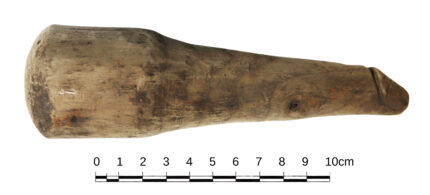A wooden artifact recovered in a 1992 excavation of the Roman fort of Vindolanda previously categorized as a darning tool has been identified as a phallus. While stone and metal phalluses are widespread throughout the Roman world, including at Vindolanda, this the first wooden example ever discovered.
It is 16 cm (6.3 inches) long and carved from a single piece of ash round in cross section. It has a wide cylindrical base that narrows to curved end. The head of the phallus is delineated by a carved line. Both the wide end and the narrow end are smoother than the shaft, evidence that they were handled. It has clear tool marks indicating the wood was very young when carved. The traces from the carving blade also suggest the phallus was not handled to the point of wear on the surface or exposed to the elements for any length of time.
 The phallus was found in a ditch from the second half of the 2nd century that was filled with more than 800 objects. Most of the fill consists of tools, shoes and craft remnants including leather offcuts. This context is likely why the phallus, which is really not subtle at all in its penile design, was mistaken for a sewing tool.
The phallus was found in a ditch from the second half of the 2nd century that was filled with more than 800 objects. Most of the fill consists of tools, shoes and craft remnants including leather offcuts. This context is likely why the phallus, which is really not subtle at all in its penile design, was mistaken for a sewing tool.
The exact function of the phallus is unknown. It is life-sized, so it’s possible that it was mounted to a herm (a stone pillar with a carved head and phallus) or statue of Priapus, or to a wall to ward off bad luck and evil intent. If that were the case, it would likely show more signs of wear.
Another possible use of the object is as a pestle. The wide end is convex, which would make it inconvenient to mount in a socket as with a statue of structure, but that smooth, rounded surface would make an ideal pounding tool. There are no food stains on what would have been the pounding surface, however.
The third possibility is as a sexual implement. Its form of course suggests usage as a dildo, and the wear on the head of the penis matches that on a much more recent (18th century) ivory phallus found inside an armchair in a Paris convent.
“If that is the case it would be, to our knowledge, the first Roman dildo that’s been encountered from archaeology. We know from Greek and Roman poetry and Greek and Roman art that they used dildos. But we haven’t had any archaeological examples found which is intriguing in itself.
“If it is that and it is found up here on the northern fringe of the empire and not down in the rich heartland of Roman Italy … it is kind of astounding.”
The re-discovered phallus has been published in the journal Antiquity and can be read here.

It could have been a replacement used by a man who was injured in an accident or a battle…
…or an “Addendum” if MORE than one soldier is needed.
A pestling convenient darning and pounding “needle in a haystack”, though maybe a bit shriveled. If there are no *food* stains, maybe there are *other* ones (remnants, leather offcuts).
Any which way, “Lubricitas” matters even in Latin: Habemus lignum!
Maybe it was used for both purposes.
I thought it was interesting that the object was found in a Roman fort. I found myself wondering about typical population of a fort in the Roman times? Was it staffed mostly by male Roman soldiers or was it a mixture of both genders? If it was mostly all male population, I was amused to think of a Roman soldier sneaking in a dildo for some bum playtime in between his patrol duties.
What??? “….much more recent (18th century) ivory phallus found inside an armchair in a Paris convent….” Livius, I really hope you will do a post on THAT!
Right?! I haven’t been able to find any solid information about it, but I am working on it because I LOVE that tidbit so much. It’s hard (lol) proof that Diderot’s La Religieuse didn’t just spring out of his depraved mind.
With piqued and delighted curiosity I wholeheartedly echo Renee’s hope above!